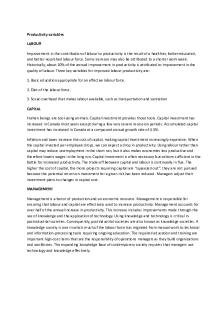Productivity variables PDF

| Title | Productivity variables |
|---|---|
| Course | Advanced operations and supply chain management |
| Institution | Yorkville University |
| Pages | 1 |
| File Size | 43.5 KB |
| File Type | |
| Total Downloads | 106 |
| Total Views | 137 |
Summary
Productivity variables...
Description
Productivity variables LABOUR Improvement in the contribution of labour to productivity is the result of a healthier, better-educated, and better-nourished labour force. Some increase may also be attributed to a shorter work week. Historically, about 10% of the annual improvement in productivity is attributed to improvement in the quality of labour. Three key variables for improved labour productivity are: 1. Basic education appropriate for an effective labour force. 2. Diet of the labour force. 3. Social overhead that makes labour available, such as transportation and sanitation CAPITAL Human beings are tool-using animals. Capital investment provides those tools. Capital investment has increased in Canada most years except during a few very severe recession periods. Accumulated capital investment has increased in Canada at a compound annual growth rate of 4.5%. Inflation and taxes increase the cost of capital, making capital investment increasingly expensive. When the capital invested per employee drops, we can expect a drop in productivity. Using labour rather than capital may reduce unemployment in the short run, but it also makes economies less productive and therefore lowers wages in the long run. Capital investment is often necessary but seldom sufficient in the battle for increased productivity. The trade-off between capital and labour is continually in flux. The higher the cost of capital, the more projects requiring capital are “squeezed out”: they are not pursued because the potential return on investment for a given risk has been reduced. Managers adjust their investment plans to changes in capital cost. MANAGEMENT Management is a factor of production and an economic resource. Management is responsible for ensuring that labour and capital are effectively used to increase productivity. Management accounts for over half of the annual increase in productivity. This increase includes improvements made through the use of knowledge and the application of technology. Using knowledge and technology is critical in postindustrial societies. Consequently, postindustrial societies are also known as knowledge societies. A knowledge society is one in which much of the labour force has migrated from manual work to technical and information-processing tasks requiring ongoing education. The required education and training are important high-cost items that are the responsibility of operations managers as they build organizations and workforces. The expanding knowledge base of contemporary society requires that managers use technology and knowledge effectively....
Similar Free PDFs

Productivity variables
- 1 Pages

Group productivity
- 7 Pages

Variables
- 5 Pages

Chapter 6 productivity software
- 5 Pages

Module 2 Productivity Strategy
- 8 Pages

User Productivity System
- 1 Pages

PRODUCTIVITY PROBLEMS 1 3 ANS
- 1 Pages
Popular Institutions
- Tinajero National High School - Annex
- Politeknik Caltex Riau
- Yokohama City University
- SGT University
- University of Al-Qadisiyah
- Divine Word College of Vigan
- Techniek College Rotterdam
- Universidade de Santiago
- Universiti Teknologi MARA Cawangan Johor Kampus Pasir Gudang
- Poltekkes Kemenkes Yogyakarta
- Baguio City National High School
- Colegio san marcos
- preparatoria uno
- Centro de Bachillerato Tecnológico Industrial y de Servicios No. 107
- Dalian Maritime University
- Quang Trung Secondary School
- Colegio Tecnológico en Informática
- Corporación Regional de Educación Superior
- Grupo CEDVA
- Dar Al Uloom University
- Centro de Estudios Preuniversitarios de la Universidad Nacional de Ingeniería
- 上智大学
- Aakash International School, Nuna Majara
- San Felipe Neri Catholic School
- Kang Chiao International School - New Taipei City
- Misamis Occidental National High School
- Institución Educativa Escuela Normal Juan Ladrilleros
- Kolehiyo ng Pantukan
- Batanes State College
- Instituto Continental
- Sekolah Menengah Kejuruan Kesehatan Kaltara (Tarakan)
- Colegio de La Inmaculada Concepcion - Cebu








